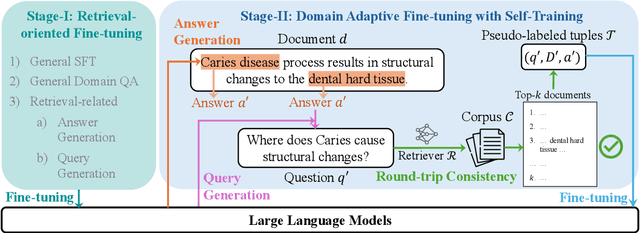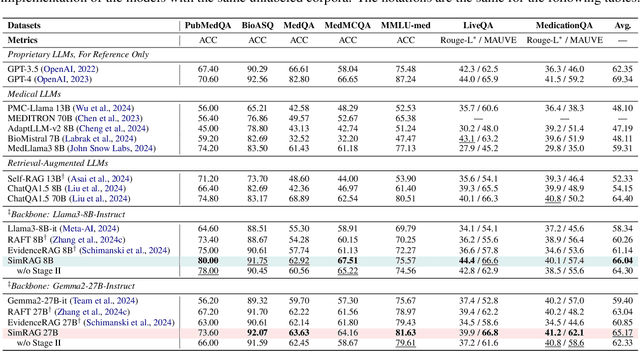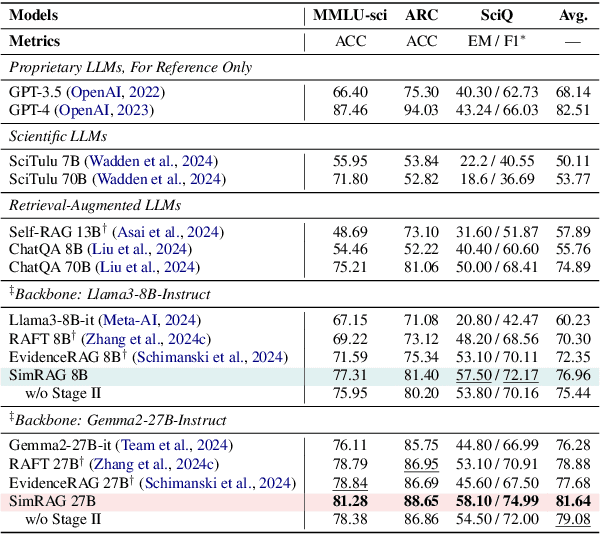Ran Xu
Collab-RAG: Boosting Retrieval-Augmented Generation for Complex Question Answering via White-Box and Black-Box LLM Collaboration
Apr 07, 2025Abstract:Retrieval-Augmented Generation (RAG) systems often struggle to handle multi-hop question-answering tasks accurately due to irrelevant context retrieval and limited complex reasoning capabilities. We introduce Collab-RAG, a collaborative training framework that leverages mutual enhancement between a white-box small language model (SLM) and a blackbox large language model (LLM) for RAG. Specifically, the SLM decomposes complex queries into simpler sub-questions, thus enhancing the accuracy of the retrieval and facilitating more effective reasoning by the black-box LLM. Concurrently, the black-box LLM provides feedback signals to improve the SLM's decomposition capability. We observe that Collab-RAG relies solely on supervision from an affordable black-box LLM without additional distillation from frontier LLMs, yet demonstrates strong generalization across multiple black-box LLMs. Experimental evaluations across five multi-hop QA datasets demonstrate that Collab-RAG substantially outperforms existing black-box-only and SLM fine-tuning baselines by 1.8%-14.2% on average. In particular, our fine-tuned 3B SLM surpasses a frozen 32B LLM in question decomposition, highlighting the efficiency of Collab-RAG in improving reasoning and retrieval for complex questions. The code of Collab-RAG is available on https://github.com/ritaranx/Collab-RAG/.
Could AI Trace and Explain the Origins of AI-Generated Images and Text?
Apr 05, 2025Abstract:AI-generated content is becoming increasingly prevalent in the real world, leading to serious ethical and societal concerns. For instance, adversaries might exploit large multimodal models (LMMs) to create images that violate ethical or legal standards, while paper reviewers may misuse large language models (LLMs) to generate reviews without genuine intellectual effort. While prior work has explored detecting AI-generated images and texts, and occasionally tracing their source models, there is a lack of a systematic and fine-grained comparative study. Important dimensions--such as AI-generated images vs. text, fully vs. partially AI-generated images, and general vs. malicious use cases--remain underexplored. Furthermore, whether AI systems like GPT-4o can explain why certain forged content is attributed to specific generative models is still an open question, with no existing benchmark addressing this. To fill this gap, we introduce AI-FAKER, a comprehensive multimodal dataset with over 280,000 samples spanning multiple LLMs and LMMs, covering both general and malicious use cases for AI-generated images and texts. Our experiments reveal two key findings: (i) AI authorship detection depends not only on the generated output but also on the model's original training intent; and (ii) GPT-4o provides highly consistent but less specific explanations when analyzing content produced by OpenAI's own models, such as DALL-E and GPT-4o itself.
ProVision: Programmatically Scaling Vision-centric Instruction Data for Multimodal Language Models
Dec 09, 2024Abstract:With the rise of multimodal applications, instruction data has become critical for training multimodal language models capable of understanding complex image-based queries. Existing practices rely on powerful but costly large language models (LLMs) or multimodal language models (MLMs) to produce instruction data. These are often prone to hallucinations, licensing issues and the generation process is often hard to scale and interpret. In this work, we present a programmatic approach that employs scene graphs as symbolic representations of images and human-written programs to systematically synthesize vision-centric instruction data. Our approach ensures the interpretability and controllability of the data generation process and scales efficiently while maintaining factual accuracy. By implementing a suite of 24 single-image, 14 multi-image instruction generators, and a scene graph generation pipeline, we build a scalable, cost-effective system: ProVision which produces diverse question-answer pairs concerning objects, attributes, relations, depth, etc., for any given image. Applied to Visual Genome and DataComp datasets, we generate over 10 million instruction data points, ProVision-10M, and leverage them in both pretraining and instruction tuning stages of MLMs. When adopted in the instruction tuning stage, our single-image instruction data yields up to a 7% improvement on the 2D split and 8% on the 3D split of CVBench, along with a 3% increase in performance on QBench2, RealWorldQA, and MMMU. Our multi-image instruction data leads to an 8% improvement on Mantis-Eval. Incorporation of our data in both pre-training and fine-tuning stages of xGen-MM-4B leads to an averaged improvement of 1.6% across 11 benchmarks.
BLIP3-KALE: Knowledge Augmented Large-Scale Dense Captions
Nov 12, 2024Abstract:We introduce BLIP3-KALE, a dataset of 218 million image-text pairs that bridges the gap between descriptive synthetic captions and factual web-scale alt-text. KALE augments synthetic dense image captions with web-scale alt-text to generate factually grounded image captions. Our two-stage approach leverages large vision-language models and language models to create knowledge-augmented captions, which are then used to train a specialized VLM for scaling up the dataset. We train vision-language models on KALE and demonstrate improvements on vision-language tasks. Our experiments show the utility of KALE for training more capable and knowledgeable multimodal models. We release the KALE dataset at https://huggingface.co/datasets/Salesforce/blip3-kale
SimRAG: Self-Improving Retrieval-Augmented Generation for Adapting Large Language Models to Specialized Domains
Oct 23, 2024



Abstract:Retrieval-augmented generation (RAG) enhances the question-answering (QA) abilities of large language models (LLMs) by integrating external knowledge. However, adapting general-purpose RAG systems to specialized fields such as science and medicine poses unique challenges due to distribution shifts and limited access to domain-specific data. To tackle this, we propose SimRAG, a self-training approach that equips the LLM with joint capabilities of question answering and question generation for domain adaptation. Our method first fine-tunes the LLM on instruction-following, question-answering, and search-related data. Then, it prompts the same LLM to generate diverse domain-relevant questions from unlabeled corpora, with an additional filtering strategy to retain high-quality synthetic examples. By leveraging these synthetic examples, the LLM can improve their performance on domain-specific RAG tasks. Experiments on 11 datasets, spanning two backbone sizes and three domains, demonstrate that SimRAG outperforms baselines by 1.2\%--8.6\%.
xGen-MM-Vid (BLIP-3-Video): You Only Need 32 Tokens to Represent a Video Even in VLMs
Oct 21, 2024



Abstract:We present xGen-MM-Vid (BLIP-3-Video): a multimodal language model for videos, particularly designed to efficiently capture temporal information over multiple frames. BLIP-3-Video takes advantage of the 'temporal encoder' in addition to the conventional visual tokenizer, which maps a sequence of tokens over multiple frames into a compact set of visual tokens. This enables BLIP3-Video to use much fewer visual tokens than its competing models (e.g., 32 vs. 4608 tokens). We explore different types of temporal encoders, including learnable spatio-temporal pooling as well as sequential models like Token Turing Machines. We experimentally confirm that BLIP-3-Video obtains video question-answering accuracies comparable to much larger state-of-the-art models (e.g., 34B), while being much smaller (i.e., 4B) and more efficient by using fewer visual tokens. The project website is at https://www.salesforceairesearch.com/opensource/xGen-MM-Vid/index.html
Trust but Verify: Programmatic VLM Evaluation in the Wild
Oct 17, 2024Abstract:Vision-Language Models (VLMs) often generate plausible but incorrect responses to visual queries. However, reliably quantifying the effect of such hallucinations in free-form responses to open-ended queries is challenging as it requires visually verifying each claim within the response. We propose Programmatic VLM Evaluation (PROVE), a new benchmarking paradigm for evaluating VLM responses to open-ended queries. To construct PROVE, we provide a large language model (LLM) with a high-fidelity scene-graph representation constructed from a hyper-detailed image caption, and prompt it to generate diverse question-answer (QA) pairs, as well as programs that can be executed over the scene graph object to verify each QA pair. We thus construct a benchmark of 10.5k challenging but visually grounded QA pairs. Next, to evaluate free-form model responses to queries in PROVE, we propose a programmatic evaluation strategy that measures both the helpfulness and truthfulness of a response within a unified scene graph-based framework. We benchmark the helpfulness-truthfulness trade-offs of a range of VLMs on PROVE, finding that very few are in-fact able to achieve a good balance between the two. Project page: \url{https://prove-explorer.netlify.app/}.
xLAM: A Family of Large Action Models to Empower AI Agent Systems
Sep 05, 2024



Abstract:Autonomous agents powered by large language models (LLMs) have attracted significant research interest. However, the open-source community faces many challenges in developing specialized models for agent tasks, driven by the scarcity of high-quality agent datasets and the absence of standard protocols in this area. We introduce and publicly release xLAM, a series of large action models designed for AI agent tasks. The xLAM series includes five models with both dense and mixture-of-expert architectures, ranging from 1B to 8x22B parameters, trained using a scalable, flexible pipeline that unifies, augments, and synthesizes diverse datasets to enhance AI agents' generalizability and performance across varied environments. Our experimental results demonstrate that xLAM consistently delivers exceptional performance across multiple agent ability benchmarks, notably securing the 1st position on the Berkeley Function-Calling Leaderboard, outperforming GPT-4, Claude-3, and many other models in terms of tool use. By releasing the xLAM series, we aim to advance the performance of open-source LLMs for autonomous AI agents, potentially accelerating progress and democratizing access to high-performance models for agent tasks. Models are available at https://huggingface.co/collections/Salesforce/xlam-models-65f00e2a0a63bbcd1c2dade4
xGen-VideoSyn-1: High-fidelity Text-to-Video Synthesis with Compressed Representations
Aug 22, 2024



Abstract:We present xGen-VideoSyn-1, a text-to-video (T2V) generation model capable of producing realistic scenes from textual descriptions. Building on recent advancements, such as OpenAI's Sora, we explore the latent diffusion model (LDM) architecture and introduce a video variational autoencoder (VidVAE). VidVAE compresses video data both spatially and temporally, significantly reducing the length of visual tokens and the computational demands associated with generating long-sequence videos. To further address the computational costs, we propose a divide-and-merge strategy that maintains temporal consistency across video segments. Our Diffusion Transformer (DiT) model incorporates spatial and temporal self-attention layers, enabling robust generalization across different timeframes and aspect ratios. We have devised a data processing pipeline from the very beginning and collected over 13M high-quality video-text pairs. The pipeline includes multiple steps such as clipping, text detection, motion estimation, aesthetics scoring, and dense captioning based on our in-house video-LLM model. Training the VidVAE and DiT models required approximately 40 and 642 H100 days, respectively. Our model supports over 14-second 720p video generation in an end-to-end way and demonstrates competitive performance against state-of-the-art T2V models.
xGen-MM (BLIP-3): A Family of Open Large Multimodal Models
Aug 16, 2024



Abstract:This report introduces xGen-MM (also known as BLIP-3), a framework for developing Large Multimodal Models (LMMs). The framework comprises meticulously curated datasets, a training recipe, model architectures, and a resulting suite of LMMs. xGen-MM, short for xGen-MultiModal, expands the Salesforce xGen initiative on foundation AI models. Our models undergo rigorous evaluation across a range of tasks, including both single and multi-image benchmarks. Our pre-trained base model exhibits strong in-context learning capabilities and the instruction-tuned model demonstrates competitive performance among open-source LMMs with similar model sizes. In addition, we introduce a safety-tuned model with DPO, aiming to mitigate harmful behaviors such as hallucinations and improve safety. We open-source our models, curated large-scale datasets, and our fine-tuning codebase to facilitate further advancements in LMM research. Associated resources will be available on our project page above.
 Add to Chrome
Add to Chrome Add to Firefox
Add to Firefox Add to Edge
Add to Edge